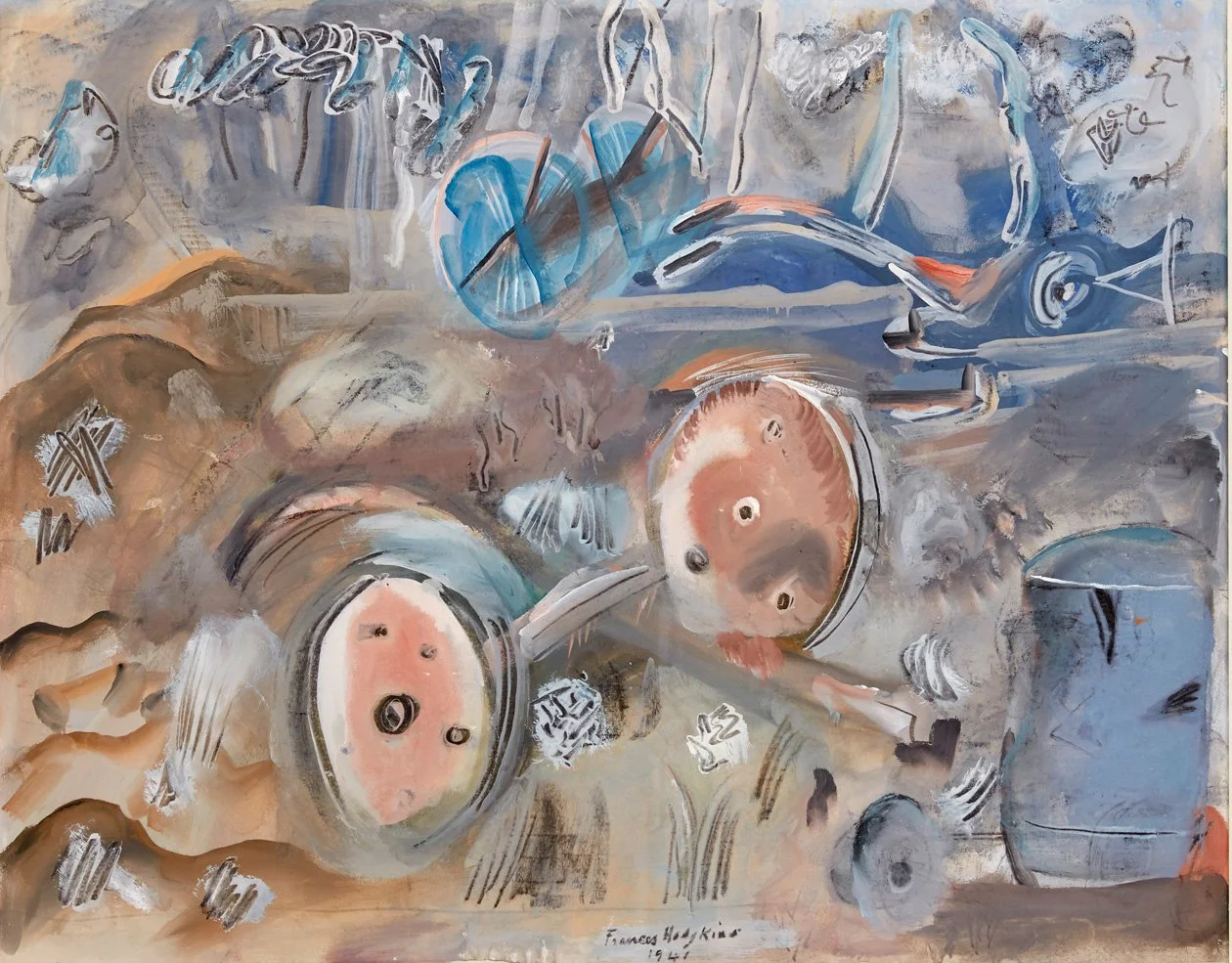FRANCES HODGKINS
The Corner of the Woods 1941
Watercolour & gouache, 40 x 51.5 cm
Signed Frances Hodgkins 1941 lower centre
From Frances Hodgkins to John Piper, 8th September 1941; Studio, East Street, Corfe Castle, Dorset
“… the nicest letter I’m ever likely to have on this earth telling me of all the nice things you and Mr Brown have fixed up for me with the ultimate glory & honour of the inner gallery thrown in - it’s too much greatness … Talking of titles, I feel mine to be banale & inadequate – if Myfanwy and you have some silver words up your sleeve, give them to me".
This is a typical Frances Hodgkins ‘farmyard’ composition, whose identifiable elements include a pair of wheels on an axle, a plough, a barrel and what are presumably other bits of discarded agricultural machinery. The scene appears to depict mechanical equipment that has been put aside and left to stand idle and commune with nature during the war whilst the farm workers were on active duty abroad. In between the various elements, flowers sprout up and in the background a horse drawn plough with harness trace can be clearly discerned before a bank of tall trees representing the woods mentioned in the title.
The Corner of the Woods is reminiscent of a slightly later painting, China Shoe (FH1203, Private Collection), a gouache of 1942, in which still-life objects take on a ‘ghostly quality’ and the composition is animated by an array of calligraphic flourishes. The subtle dark colouring and somewhat mysterious mood connect it closely with British Neo-Romanticism, and in particular with the works of artists John Piper, John Craxton and John Minton.
Wheels, which make a dominant appearance in The Corner of the Woods, were a recurring motif in Hodgkins’ work, and were also common in the neo-romantic and surrealist imagery of the time, as in the work of Paul Nash. The theme had various interpretations, such as suggestions of the self, or modernity, while it could also have an anthropomorphic aspect, with wheel hubs being read as eyes. Such forms are apparent in Hodgkins’ 1942 gouache Broken Tractor (FH1215, Tate), of which Elizabeth Eastmond describes that vehicle’s wheel hubs as looking like “grotesque, anguished eyes.” Broken Tractor was included in the exhibition Gouaches by Frances Hodgkins at the Lefevre Galleries in March-April 1943, along with another following the wheel theme, The Mill Wheel (FH1219, Museum of New Zealand Te Papa Tongarewa), while there were also several Welsh subjects including; Barn Interior, Dolaucothy (FH1209, Museum of New Zealand Te Papa Tongarewa), Green Valley, Carmarthenshire (FH1216, Dunedin Public Art Gallery) and Welsh Farm (FH1226, Dunedin Public Art Gallery).
Hodgkins’ 1943 exhibition, Gouaches by Frances Hodgkins – A new series of Gouaches painted during 1942–3, was held at the Lefevre Galleries, which had recently reopened after closing in July 1940 due to the falling demand for art during wartime and the difficulty of obtaining paintings. With this exhibition Hodgkins was able to realise her long desired aim of presenting a thematically unified display of recent work, in this case produced in the period 1942-3. Her 1943 exhibition was also significant because her paintings were shown alongside another exhibition, Picasso and his Contemporaries, which was a departure at Lefevre, and in so doing it demonstrated her affinities with French painting.
Exhibited
Wellington, Kirkcaldie & Stains, Frances Hodgkins, Works from Private Collections, August 1989, No. 40 Auckland,
Jonathan Grant Gallery, Frances Hodgkins: A New Zealand Modernist, May 2019, No. 11
Provenance
Private Collection U.K. until 1979
Sotheby’s, Modern British Drawings, Paintings & Sculpture, London 27/6/79 No. 18
Private Collection, Wellington
Private Collection, Auckland
Reference
Frances Hodgkins database (FH1199) www.completefranceshodgkins.com
Literature
H. & A. Legatt, Frances Hodgkins, Works from Private Collections (Wellington 1989) p. 14 (illustrated fig. 22)
Jonathan Grant Gallery, Frances Hodgkins. A New Zealand Modernist (Auckland 2019) p.31 (illustrated p. 32)

